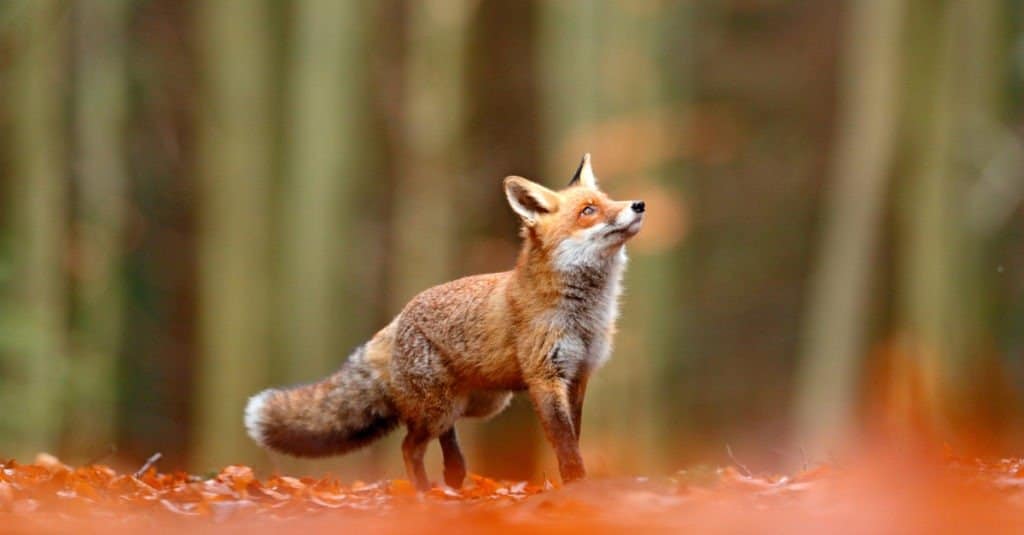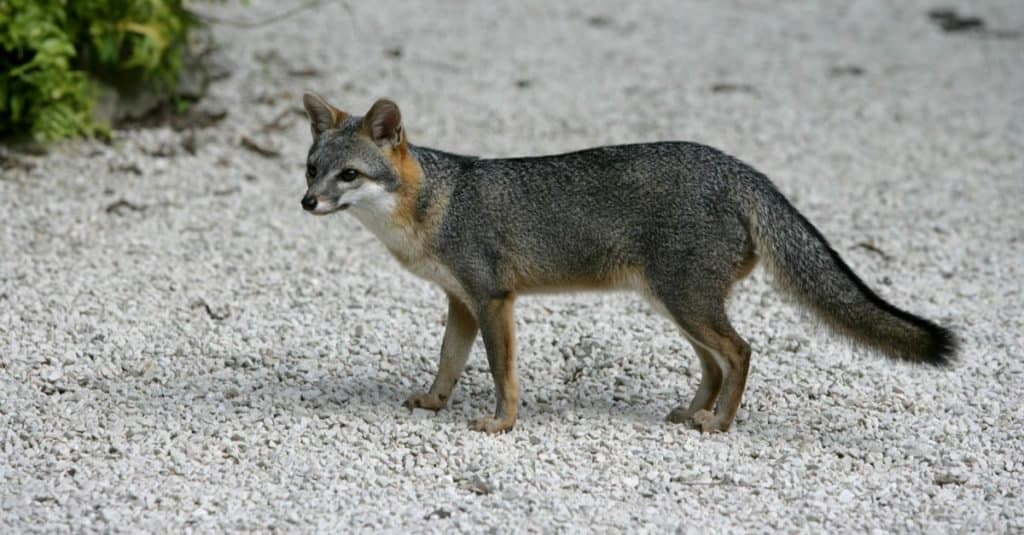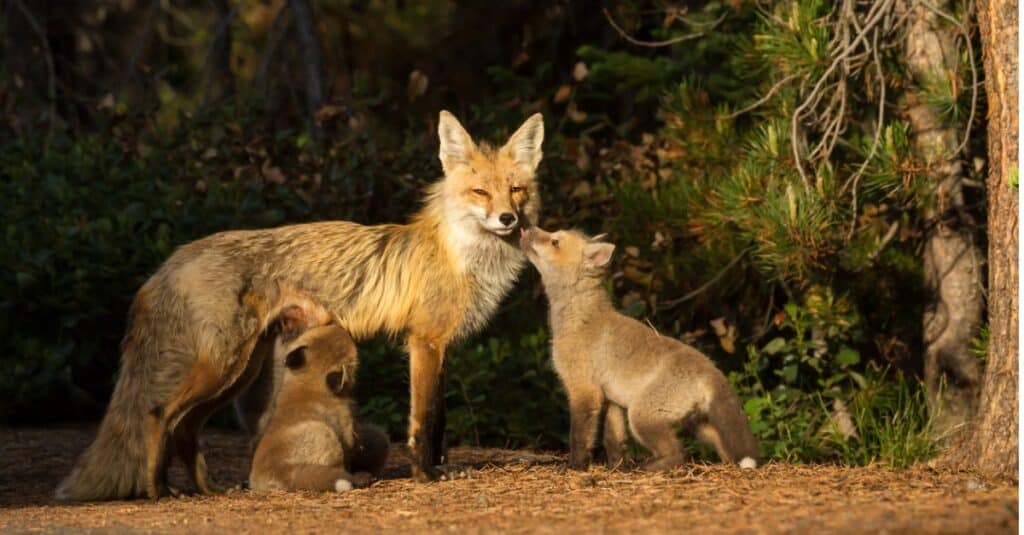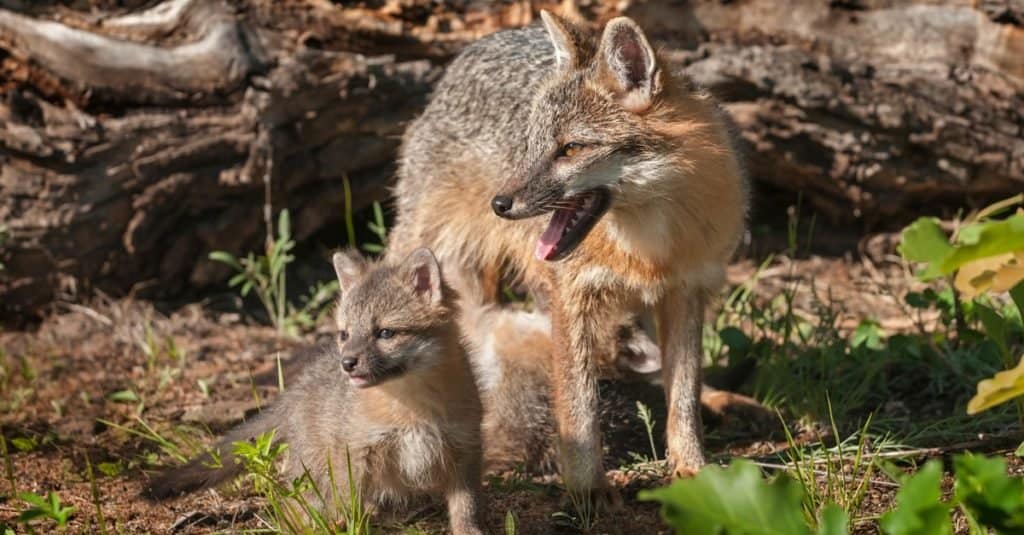South Carolina is home to a wide range of wildlife, and among them, foxes hold a special place. These intelligent, adaptable creatures are an integral part of the region’s ecosystem. There are two primary species of foxes found in the Palmetto State: the red fox and the gray fox. Both have unique characteristics, behaviors, and habitats that make them fascinating subjects for nature enthusiasts. This blog aims to provide an in-depth look into these two species of foxes – their traits, where they live, their role in the ecosystem, and how we can help protect them.
2 Types of Foxes in South Carolina

There are two types of foxes in South Carolina.
©Ondrej Prosicky/Shutterstock.com
Red Foxes
The red fox is named for its vibrant red-orange coat. It has a white underbelly, black ears, and a bushy tail with a white tip. Adult red foxes typically weigh between 7 to 15 pounds.
Red foxes are crepuscular, meaning they are most active during dawn and dusk. They are known for their incredible adaptability, able to survive in various environments, from forests to suburban areas. These foxes are also quite vocal, using a series of barks, screams, and howls to communicate.
Gray Foxes
Gray foxes have a slightly grizzled appearance due to their peppered gray fur, which covers most of their body except for the rusty-red parts of their neck, legs, and underside. They are smaller than red foxes, averaging around 5 to 9 pounds.
Unlike red foxes, gray foxes are more elusive and prefer woodland habitats. They have the unique ability among canids to climb trees, often using this skill to escape predators or find food.
Distribution and Habitats of Foxes in South Carolina

Gray foxes are one of the only canids that can climb trees.
©Erni/Shutterstock.com
Red foxes make their home throughout South Carolina. They thrive in a variety of habitats, including forests, grasslands, farmlands, and even suburban areas. These adaptable creatures make dens in forests or burrow under man-made structures in urban areas.
Gray foxes are also widely distributed across the state but prefer more secluded woodland areas. They are skillful climbers and often retreat into trees to escape predators. They sometimes make dens high up in rocky outcrops.
The Role Foxes Play in South Carolina’s Ecosystem
Foxes play a crucial predatory role in South Carolina’s ecosystem. Their diet primarily consists of rodents, rabbits, birds, frogs, fruits, and insects. By controlling these populations, foxes help maintain a balanced ecosystem.
Foxes also serve as prey to larger predators such as bobcats and coyotes. Thus, they form an important link in the food chain.
Fox Reproduction, Mating, Relationships, and Pregnancy
Foxes are typically monogamous, meaning they will stick with one mate for the duration of their lives. Courtship and mating typically occur in the winter months of January and February. During this time, the male will court the female with gifts of food and will perform elaborate courtship displays. After mating, the gestation period for foxes is approximately 53 days.
During the pregnancy, the female will build a den in order to give birth. These dens are typically located in hollow logs or under the roots of a tree. Foxes give birth to a litter of usually 4-6 kits, who are born blind and deaf. The mother will take care of the kits until they are old enough to hunt for their own food.
The fox family will stick together until the kits are old enough to be on their own, usually around 8 or 9 months. Once the kits are independent, the male will typically leave and search for a new mate. Fox parents will often stay in close proximity to the litter to provide protection and guidance until they are fully grown.
All About Baby Foxes

Mother foxes are very protective of their young kits.
©iStock.com/Wendy/Jeff Sparks/Torquemada
Baby foxes, also known as kits, are born blind and deaf, weighing only a few ounces. They are born with a thin coat of fur, and their eyes and ears don’t open until they are about two weeks old. During their first two weeks, they rely on their mother’s milk to grow and develop.
Once they reach two weeks of age, baby foxes begin to explore their surroundings and are often playing and tussling with their siblings. They start to develop their senses and can respond to sound, light, and smell. At this stage, their fur also becomes thicker, and they will typically double their weight.
At four weeks of age, baby foxes become more mobile and take their first steps. They can now see and hear and have developed their sense of smell. Their fur continues to grow and thicken into characteristic fox fur. They begin to eat solid foods, such as insects and small rodents.
By eight weeks of age, baby foxes can now take care of themselves and will start to venture away from the den. They begin to hunt and explore their environment, learning how to survive on their own. Their fur is now fully developed, and they have grown significantly. They remain with their family until they are about eight months old when they become ready to live independently.
Fox Communication

Foxes in South Carolina live in various types of habitats. They have learned to adapt to survive.
©Holly Kuchera/Shutterstock.com
Foxes are an incredibly vocal species and use a variety of vocalizations and body language to communicate. They use a combination of vocalizations and body language to convey a range of messages, including warnings, territorial boundaries, and even affection.
Foxes produce a variety of vocalizations, including barks, screams, and howls. When a fox barks, it usually indicates a warning to other foxes or predators. Screams are usually associated with foxes in distress. They also make this noise during mating season. Howls are primarily used to communicate with other foxes and are used to mark territory and alert other foxes of their presence.
Foxes use a variety of grunts, clicks, and whines to communicate with one another. Some of these verbal cues are to show submission, while others are to show dominance. Foxes will also use these verbal cues to express their emotions, such as happiness or excitement.
Foxes, like many animals, use body language to convey different messages. A fox will typically fluff up its fur when it is feeling aggressive or threatened. Additionally, they will often hold their tail high when they are trying to show dominance. If a fox is feeling relaxed, it will usually lay its ears flat against its head.
Threats to Foxes in South Carolina
Fox populations face several threats in South Carolina. Natural predators include larger carnivores like bobcats and coyotes. Diseases are another major concern; both red and gray foxes are susceptible to mange and rabies.
Human activities pose significant threats too. Habitat destruction due to urban development often forces foxes into conflict with humans. Hunting and road accidents further contribute to their declining numbers.
Conservation efforts are underway to protect these species. Hunting restrictions are in place, and there is increasing emphasis on preserving natural habitats.
How to Respect and Protect Fox Populations
When interacting with foxes in the wild, it’s crucial to maintain a safe distance and avoid feeding them – this can lead to dependency on human-provided food.
To support conservation efforts, consider donating to or volunteering with local wildlife organizations. Advocating for responsible land-use policies can also help protect fox habitats.
Other Mammals in South Carolina

Raccoons are another fascinating mammal that lives in South Carolina.
©Georgi Baird/Shutterstock.com
In addition to foxes, South Carolina is home to several other mammals like white-tailed deer, eastern cottontail rabbits, gray squirrels, beavers, raccoons, bats, and much more. Each plays a unique role in the ecosystem making South Carolina’s wildlife landscape diverse and vibrant.
In conclusion, the red and gray foxes of South Carolina are fascinating creatures worth appreciating and protecting. By understanding more about these species – their behaviors, habitats, and roles in the ecosystem – we can better ensure their survival for future generations to enjoy.
The photo featured at the top of this post is © RT Images/Shutterstock.com
Thank you for reading! Have some feedback for us? Contact the AZ Animals editorial team.







